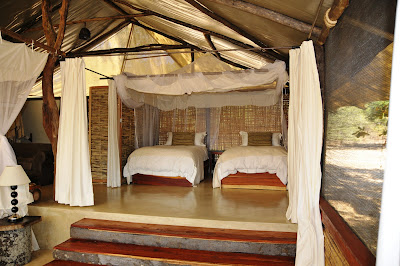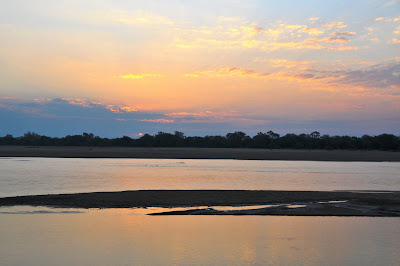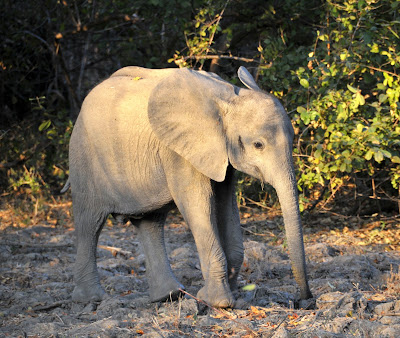It took about an hour and a half to drive from the crossing point on the

The view of the lounge and dining room area at Kalamu Lagoon Camp, from the parking area
Kalamu Lagoon Camp has a very pleasant setting with good views over the water of a large lagoon where there are lots of birds, hippo & various other animals to be seen. The best feature of the camp is its expansive open lounge area with adjacent pool and fireplace area. Much of the lounge is shaded by some magnificent trees.

Part of the lounge area at Kalamu Lagoon Camp

Kathleen on the deck area at Kalamu

The rooms at Kalamu are quite large, hybrid structures with tented (canvas) roof, but walls constructed of reeds and canvas, the end result being reminiscent of a traditional Zambian bush camp but will all the modern comforts including excellent solar lighting, hot and cold water on demand, a shower, separate toilet, large bed/sleeping area with a great view, and an elevated sitting area. The camp has 8 rooms in total including 2 family units.

A double room at Kalamu

Another view of a standard room at Kalamu

The lounge area of the room with the bathroom in the background

A family room at Kalamu; the separate 'room' with the two single beds can be closed off with a partition

A different view of the interior of a family room at Kalamu
Our afternoon activity commenced at just after 4, and we spent a very pleasant 3+ hours with Luckson, our superbly qualified guide, spending some time at various points, looking at everything around us, and particularly enjoying the viewpoint from the Kalamu Bush Camp. One of the most special moments of our entire trip to date occurred when a large breeding herd of elephants emerged from the tree line to our far right and started to walk towards the water. First there was just one. Then a second and third elephant appeared. Soon there were ten, fifteen, twenty, thirty and eventually nearly 50 elephants, including a very tiny baby. After spending some time drinking, the herd slowly started making its way across the

Getting ready for sundowners at Kalamu Lagoon Camp - near the Bush Camp site

Sundowners are of course associated with the sun setting. And with gin & tonic, or whatever you prefer.
Not much later, we noticed a large hawk-like bird with rather pointed wings, like a lanner or peregrine, but mostly dark in appearance, almost fluttering around the edge of the water over the lagoon. By now it was well after sunset, and my first thought was ‘Bat Hawk’. Luckson had some good looks as well and between the two of us we agreed that it was really the only possibility. This was not only a life bird for me, it was a sighting right up there with the African Finfoot and the Painted Snipe. These rarely seen, mostly crepuscular birds have some peculiar habits such as catching and eating their prey in flight, which I believe is what we saw.

An elephant seen on the afternoon game drive at Kalamu

Keeping a safe distance
Very happy, we returned to camp for dinner consisting of curried potato and onions, a vegetable medley with broccoli, basmati rice, fresh green salad, and freshly baked bread rolls. Really tasty and healthy. Dinner was followed by some bananas with a toffee sauce.
The next morning we slept in until 0630 with tea and coffee served at 0700. Full breakfast was served at 0730 with eggs to order, beans, potato and onions, muffins, toast, fresh fruit salad, and oats with soy milk. Shortly afterward we left on an hour long drive through the mopane woodland destined for a village (where several of the Kalamu staff members live) just outside the National Park.
I still do not know quite what to make of the trip to the village. I am always a rather reluctant participant in this type of cultural activity, as it often verges on being paternalistic, with some degree of social discomfort being suffered by both the visitor and the residents alike. Fortunately this trip did not feel like that at all; the adult villagers pretty much took it in their stride, continuing with their day to day life, such as cooking, washing up and attending to other chores and activities. It was interesting to see them prepare some beans in a pot, as well as cutting up some fresh okra. A good vegan meal in the making, especially when served with nshima (the local staple food make of ground corn, very much like polenta but just white).
Our guide Luckson drove us around the village, and we walked around the school, some of the homesteads, and down to the river where we saw a rudimentary well (actually just pits dug into a dry riverbed where clear water collects through seepage). Everywhere we were followed around by a bunch of very happy, smiling, laughing kids. It was a school holiday so they were all out and about, relishing the opportunity to interact with some people from beyond the village. What is your name? How are you? My name is John. We were bombarded with questions and then with requests for photographs, which we were happy to oblige.

Village kids vying for a good photographic position

A small group of village children with someone's doll being displayed

The baby was somewhat overcome with our presence and the camera and needed some reassurance

Friends

This boy insisted on several pics of just himself; it was not too difficult to oblige
It is painfully clear that these people have very little in the way of earthly possessions and that they live a tough and difficult life. They do not have running water, toilet facilities like ours, baths or showers, electricity, or proper cooking facilities. Essentially they have absolutely none of the most basic domestic conveniences which we more than take for granted in the developed world. I was later told that their hard life gets even worse in the rainy season when they are totally cut off from the outside world, unable to do as much as a visit a store to buy food or anything else. For several months there are flooded rivers which prevent them from visiting Mfuwe, about 35 km away.
It is heartbreaking to see such grinding poverty in front of your very own eyes. Even so, the children hardly notice it. They are all happy and seemingly content, with great big smiles, behaving just like kids would anywhere in the world. Some are bold, some are shy and others look at you with soulful, intelligent eyes deserving of a fate better than the hand they’ve been dealt. Visiting the local community school illustrates how tough a task it is for kids born here, to break out of the harsh situation they find themselves in. The building is the most basic of basic rectangular structures, with two large ‘blocks’ and a central smaller room (headmaster’s office/library). There is no running water or ablution blocks, and all that can be seen are a few scattered old desks and some cheap plastic chairs but clearly not enough for everybody. There is no glass in the window frames, glass being too expensive. Each teaching 'block' with its bare concrete floor houses three groups or classes which are taught all at the same time, by volunteer teachers. For some reason community schools like these are not supported by the Zambian Government, other than by supplying them with the syllabus as to what has to be taught for each grade level. Kathleen and I resolved to do something to help the children at this school, perhaps by sending some books.

Exterior view of the community school at the village near Kalamu

Interior of a school room or 'block' at the village near Kalamu



A young girl with a makeshift balloon
We returned to the lodge (after having running the tsetse corridor in the mopane woodland) in a subdued mood. Lunch consisted of various bean dishes & salads, as well as a fresh green salad, risotto, and other veggies. The afternoon & early evening game drive was relatively quiet, but we had some great views of three very young elephant bulls, some barely 3 years old, wandering around all on their own; certainly a risky situation for them. A special treat was drinks for two under the stars at a table along the Kalamu Lagoon opposite camp. Afterwards Luckson pointed out some constellations and other celestial bodies visible in the southern sky at this time of the year.


At this age they are very vulnerable to attack by lions







No comments:
Post a Comment